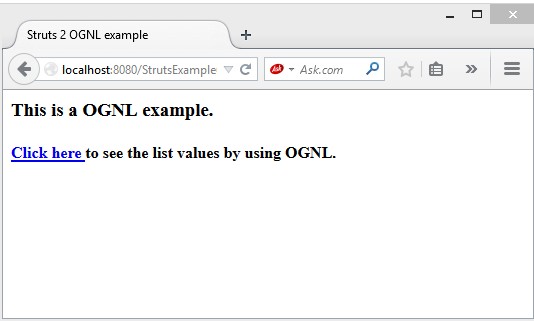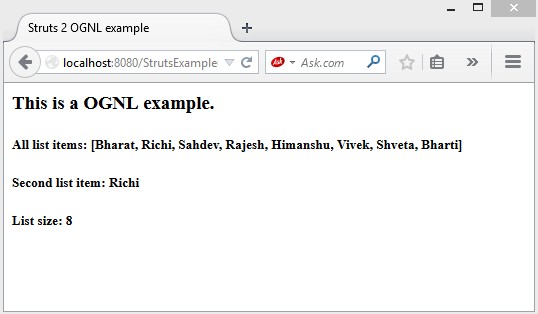OGNL refers to Object Graph Navigation Language. It is mainly used to set or get the value of a java bean property.
Use of OGNL in struts 2.
- As an expression language it is used in forms and response UI pages.
- It is used to access the objects in ValueStack.
- It is used in type conversion. When a form is submitted form values are transmitted as string values. OGNL converts these values to the specific types at the time of setting these values to the java beans.
Syntax of accessing the action property using OGNL.
<s:property value="propertyName"/>
Syntax of accessing the property from a scope (request, session or application) using OGNL.
<s:property name="#scopeName. propertyName "/>
Example:
test.jsp
<%@ taglib uri="/struts-tags" prefix="s"%> <html> <head> <title>Struts 2 OGNL example</title> </head> <body> <h3>This is a OGNL example.</h3> <h4><a href="welcome">Click here </a> to see the list values by using OGNL.</h4> </body> </html> |
web.xml
<?xml version="1.0" encoding="UTF-8"?> <web-app version="2.5" xmlns="http://java.sun.com/xml/ns/javaee" xmlns:xsi="http://www.w3.org/2001/XMLSchema-instance" xsi:schemaLocation="http://java.sun.com/xml/ns/javaee http://java.sun.com/xml/ns/javaee/web-app_2_5.xsd"> <filter> <filter-name>struts2</filter-name> <filter-class> org.apache.struts2.dispatcher.ng. filter.StrutsPrepareAndExecuteFilter </filter-class> </filter> <filter-mapping> <filter-name>struts2</filter-name> <url-pattern>/*</url-pattern> </filter-mapping> <welcome-file-list> <welcome-file>test.jsp</welcome-file> </welcome-file-list> </web-app> |
struts.xml
<!DOCTYPE struts PUBLIC "-//Apache Software Foundation//DTD Struts Configuration 2.0//EN" "http://struts.apache.org/dtds/struts-2.0.dtd"> <struts> <package name="user" extends="struts-default"> <action name="welcome" class="com.w3schools.action.Test"> <result name="success">/welcome.jsp</result> </action> </package> </struts> |
Test.java
import java.util.ArrayList; import java.util.List; /** * This class is used as an action class. * @author w3schools */ public class Test { //data members private List<String> myList = new ArrayList<String>(); //business logic public String execute(){ myList.add("Bharat"); myList.add("Richi"); myList.add("Sahdev"); myList.add("Rajesh"); myList.add("Himanshu"); myList.add("Vivek"); myList.add("Shveta"); myList.add("Bharti"); return "success"; } public List<String> getMyList() { return myList; } public void setMyList(List<String> myList) { this.myList = myList; } } |
welcome.jsp
<%@ taglib uri="/struts-tags" prefix="s"%> <html> <head> <title>Struts 2 OGNL example</title> </head> <body> <h3>This is a OGNL example.</h3> <strong><em> All list items: <s:property value="myList" /> </em></strong> <strong><em> Second list item: <s:property value="myList[1]" /> </em></strong> <strong><em> List size: <s:property value="myList.size" /> </em></strong> </body> </html> |
Output:

Click on the link.

Download this example.
Next Topic: Value Stack in struts 2 with example.
Previous Topic: Multiple configuration file in Struts 2 with example.